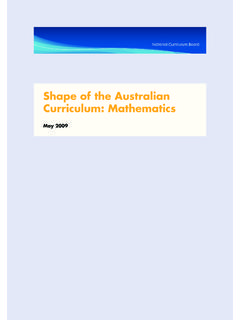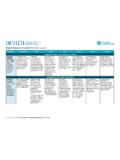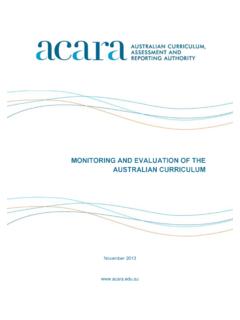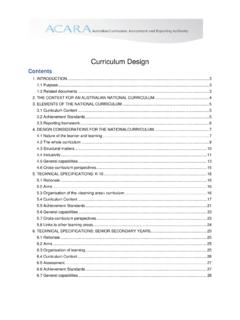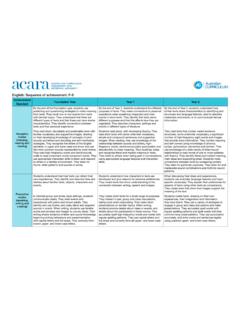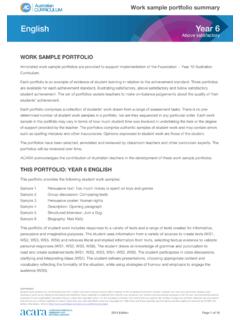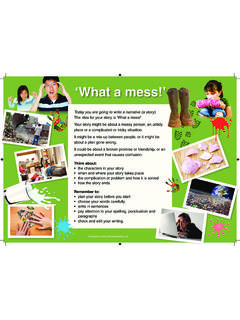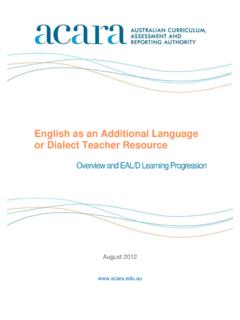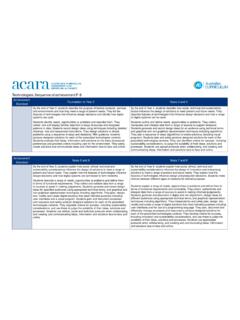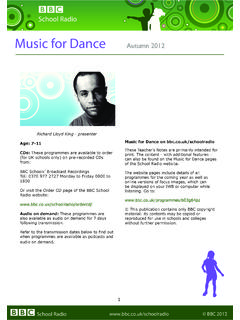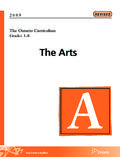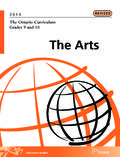Transcription of Shape of the Australian Curriculum: The Arts
1 Shape of the Australian Curriculum: The 2011 Australian curriculum , Assessment and Reporting Authority 2011 This work is copyright. You may download, display, print and reproduce this material in unaltered form only (retaining this notice) for your personal, non-commercial use or use within your other rights are reserved. Requests and inquiries concerning reproduction and rights should be addressed to:ACARA Copyright Administration, ACARA Level 10, 255 Pitt Street Sydney NSW 2000 1 Shape of the Australian curriculum .
2 The Arts Table of Contents Purpose 2 Introduction 3 The Arts Learning Area 4 Structure of the Australian Arts curriculum 5 Scope and Sequence of the Australian Arts curriculum 7 dance 8 Drama 10 Media Arts 12 Music 14 Visual Arts 16 Considerations 19 Links to other learning areas 19 The place of design in the curriculum 19 Safe practices in the Arts 19 Students with disability 19 Key terms 20 The Arts and the Cross- curriculum Priorities 21 The Arts and the General Capabilities 23 The Arts Industry and Community 25 Glossary 26 References 27 2 Shape of the Australian curriculum : The Arts Purpose 1. The Shape of the Australian curriculum : The Arts provides broad direction on the purpose, structure and organisation of the Arts curriculum .
3 It is intended to guide the writing of the Australian Arts curriculum from Foundation to Year 12. 2. This paper has been prepared following analysis of extensive consultation feedback to the National Arts curriculum Initial Advice Paper (3 May 2010) and draft Shape of the Australian curriculum : The Arts Paper (8 October 2010), and decisions taken by the ACARA Board. 3. The paper should be read in conjunction with The Shape of the Australian curriculum 3 Shape of the Australian curriculum : The Arts Introduction 4. An education rich in the Arts maximises opportunities for learners to engage with innovative thinkers and leaders and to experience the Arts both as audience members and as artists. Such an education is vital to students success as individuals and as members of society, emphasising not only creativity and imagination, but also the values of cultural understanding and social harmony that the Arts can engender (National Education and the Arts Statement, 2007).
4 5. Through studying and engaging in the Arts, students will develop specific knowledge, skills and processes, and also create art works. Through learning to appraise and critique art works, artists and artistic practices, they will learn to value the uniqueness of each art form, and to understand that all art forms are interconnected. Students will come to understand the social, historical and cultural contexts of art forms. Students will learn that the Arts are central to creative communities and cultures. The Arts provide evidence of the creative and cultural life of a community. 6. In a curriculum for the twenty-first century, students will experience and learn about five Arts subjects: dance , drama, media arts, music and visual arts.
5 In the Arts, students need to know what questions to ask, especially when encountering an art work of another era, culture or unfamiliar medium. Young Australians need the confidence to access the Arts, and to understand the contemporary manifestations of each art form as well as their social, cultural and historical contexts. 7. As emerging critical and creative thinkers, students will gain the confidence and the tools to understand and critique the Arts in everyday life. Students will learn that the Arts exist in process as much as in finished artistic products. Process does not have to result in a product or performance. Through their Arts studies, students will discover that artists work both individually and in groups, and that the Arts connect many creative and mainstream industries contributing to the development of a vibrant, modern and inclusive Australian society.
6 4 Shape of the Australian curriculum : The Arts The Arts Learning Area 8. The Australian curriculum : The Arts will comprise five subjects: dance Drama Media Arts Music Visual Arts. 9. The Australian curriculum for the Arts will be based on the assumption that all young Australians are entitled to engage with the five Arts subjects and should be given an opportunity to experience the special knowledge and skills base of each. All students will study the five Arts subjects dance , drama, media arts, music and visual arts from Foundation to the end of primary school. Schools will be best placed to determine how this will occur. From the first year of secondary school (Year 7 or 8), students will have an opportunity to experience some Arts subjects in greater depth and to specialise in one or more Arts subjects.
7 Schools may continue to offer all Arts subjects. This will be determined by their state/territory jurisdiction and/or the school. In Years 9 12, students will be able to specialise in one or more Arts subjects as part of their overall curriculum package. 10. The curriculum for each Arts subject will be organised in the following bands: Foundation to Year 2 Years 3 4 Years 5 6 Years 7 8 Years 9 10 Senior secondary (Years 11 12). 11. Learning in the Arts and the development of aesthetic knowledge are sequential and cumulative. The new content, skills and processes specified in each band will be revisited in increasing complexity and sophistication in later bands. 12. Allocation of time for teaching the Arts learning area will be a school-based decision.
8 Notional hours for each band of schooling will guide the writers of the Australian Arts curriculum as follows: 120 hours across F 2; 100 hours across Years 3 4; 100 hours across Years 5 6; 160 hours across Years 7 8 and 160 hours across Years 9 10. 13. Schools are best placed to determine how learning in the Arts will be delivered. These decisions will take account of the different approaches that can be taken for each subject in the Arts. For example, some subjects in the Arts require frequent brief tuition while others require more intense immersion less frequently. 5 Shape of the Australian curriculum : The Arts Structure of the Australian Arts curriculum 14. Each subject in the Arts is unique, with its own discrete knowledge, symbols, language, processes and skills.
9 15. In broad terms, learning in the Arts involves making and responding. Students learn as artists, by making art works that communicate to audiences. They learn as audiences, by responding critically to the Arts. These actions are taught together as each depends on the other. 16. Making and responding will provide overarching organisers for the Arts curriculum and will provide a consistent structure for the primary years and for generalist teachers. Within these broad organisers, each subject in the Arts will have specific terminology, concepts and processes that serve as subject organisers. In this curriculum , making will be described in art form-specific ways within each Arts subject. Responding will be described in more general terms, which will be applied across the five Arts subjects.
10 The curriculum will recognise equally the distinctiveness of dance , drama, media arts, music and visual arts. It also recognises connections between art forms. 17. Students will learn to use art form-specific concepts, skills and processes in their making and responding. Students will develop aesthetic knowledge through their Arts learning. 18. Students will make art works by using the elements of an art form. They will work from an idea, an intention, an expressive or imaginative impulse, or an external stimulus. They will imagine, create and design art works. Through disciplined practice, s tudents will learn to use and manage the materials, instruments and skills of the art form to prepare, develop, produce and present art.
